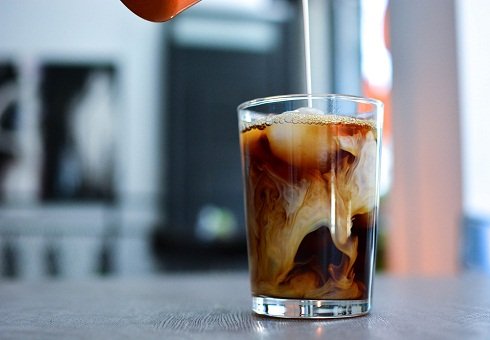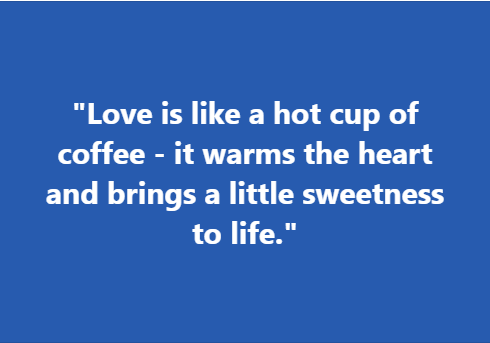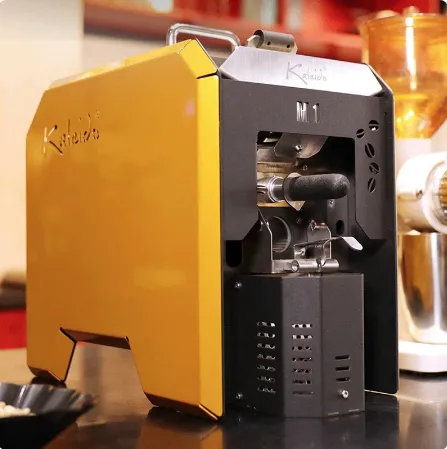Find out the difference between cold brew and iced coffee, learn how to make cold brew at home, and discover the benefits of drinking cold brew!
Table of Contents
If you love coffee, you’ve likely heard of cold brew coffee. It has been gaining popularity in recent years as more and more people seek out a way to make a delicious cup of coffee without the hassle of traditional brewing methods.
Cold brew is a unique type of coffee that is brewed with cold water over an extended period of time, resulting in a smooth and less acidic cup than regular brewed coffee.
Cold Brew Coffee
Cold brew coffee is a refreshing and smooth alternative to traditional hot coffee.
The process involves steeping coarse-ground coffee beans in cold water for an extended period, typically 12-24 hours.
This method produces a concentrate that can be diluted with water or milk before serving.
Cold brew coffee has gained popularity in recent years due to its unique taste and lower acidity levels compared to hot brewed coffee.
One of the key benefits of cold brew coffee is its versatility. It can be served over ice with your favorite creamer or milk, blended into a frappuccino-style drink, or even used as the base for cocktails.
Additionally, because it is less acidic than hot brewed coffee, it can be easier on sensitive stomachs and teeth.
It’s important to note that cold brew coffee does have higher caffeine content per ounce than hot brewed coffee due to the prolonged steeping time.
As with any caffeinated beverage, it’s essential to consume in moderation and pay attention to how your body reacts.
Overall, if you’re looking for a refreshing take on your daily cup of joe or want an introduction to specialty coffee drinks, give the cold brew a try!
Origins of Cold Brew
Cold-brew coffee has taken the world by storm in recent years, becoming a popular alternative to hot-brewed coffee. But where did it all begin?
The origins of cold brew can be traced back to Japan in the 1600s.
Japanese tea makers began to experiment with using cold water to extract flavor from tea leaves, which led to the development of a similar process for coffee.
In the early 20th century, Dutch traders introduced cold brew to Europe and later, America.
It gained popularity among those who preferred a less bitter taste than traditional hot brewed coffee.
However, it wasn’t until the 1960s that Toddy Coffee Company founder Todd Simpson patented a device specifically designed for making cold brew at home.
Nowadays, cold brew has become a staple in many coffee shops around the world and is enjoyed by millions of coffee lovers looking for a smooth and refreshing caffeine fix.
Its popularity continues to grow as more people discover its unique flavor profile and benefits over traditional brewing methods such as reduced acidity levels and longer shelf life.
Brewing Process
The brewing process is a crucial step in making the perfect cup of cold brew coffee.
Unlike traditional hot brewing methods, cold brew coffee is made by steeping coffee grounds in room temperature water for an extended period- usually 12-24 hours.
The result is a smooth and less acidic cup of coffee that is perfect for summer days.
When starting the brewing process, make sure to use high-quality beans as they will have a significant impact on the flavor of your final product.
Once you’ve selected your beans, grind them coarsely and combine them with filtered water in a large container or pitcher.
Stir gently to ensure all the grounds are submerged in water and let it sit at room temperature for several hours.
After waiting patiently for 12-24 hours, it’s time to strain out the grounds from the liquid using either a cheesecloth or fine-mesh strainer.
The leftover concentrate can be stored in an airtight container in your refrigerator for up to two weeks, making it easy to enjoy your favorite cup of cold brew anytime you want without having to go through the lengthy brewing process every time.
Flavor Profile
When it comes to cold brew coffee, the flavor profile is an important factor that sets it apart from other brewing methods.
Cold brew coffee has a smoother and less acidic taste compared to hot brewed coffee.
This is because the cold water extraction process results in a lower acid concentration and a gentler flavor.
The flavor profile of cold brew coffee tends to highlight its natural sweetness, making it an excellent option for those who prefer their coffee without sugar or cream.
While cold brew is generally known for its sweet and smooth taste, the flavor profile can vary depending on several factors such as roast level and bean origin.
Lighter roasts tend to have brighter flavors with fruity notes, while darker roasts offer richer flavors with hints of chocolate or caramel.
The type of beans used in a cold brew also plays a significant role in its flavor profile.
For instance, African coffees are known for their floral and citrusy notes, whereas South American coffees have nutty and chocolaty undertones.
Overall, understanding the flavor profile of cold brew coffee can help you choose the right beans and brewing method to achieve your desired taste experience.
Whether you prefer bright fruity notes or rich chocolatey undertones, there’s sure to be a perfect cup of cold brew out there waiting for you!
Health Benefits
Drinking cold brew coffee has numerous health benefits. It is rich in antioxidants, which are responsible for protecting the body against free radicals that can cause cancer and other chronic diseases.
Cold brew coffee also contains compounds such as caffeine, chlorogenic acid, and trigonelline that have been associated with reducing the risk of heart disease, type 2 diabetes, and liver disease.
Additionally, cold-brew coffee has a lower acidity level than hot-brewed coffee.
This makes it a great alternative for people who experience acid reflux or stomach problems after drinking hot coffee.
The low acidity level also means that cold brew coffee is gentler on your teeth enamel compared to hot brewed coffee, making it less likely to cause tooth decay or sensitivity.
Overall, incorporating cold brew coffee into your daily routine can be beneficial for your health.
However, like all things in life, moderation is key! So go ahead and enjoy a refreshing cup of cold brew every once in a while without worrying about its impact on your health.
Making at Home
Making cold brew coffee at home is a fun and easy process that can save you time and money in the long run.
To get started, all you need is some freshly roasted coffee beans, filtered water, and a large container or jar.
Simply grind your beans to a coarse consistency, add them to your container with water, stir gently, and let it sit for 12-24 hours to steep.
Once the brewing process is complete, strain out the grounds using a fine mesh strainer or cheesecloth.
The resulting concentrate can be stored in an air-tight container in your refrigerator for up to two weeks.
To enjoy a delicious cup of cold brew coffee at home, simply dilute the concentrate with water or milk to taste and serve over ice.
Overall, making cold brew coffee at home is a simple and cost-effective way to enjoy this popular drink without having to leave your house.
With just a few basic ingredients and some patience during the brewing process, you can create a delicious batch of cold brew that will keep you caffeinated throughout the week!
Brewing Tips & Techniques
Cold brew coffee is a delicious and refreshing way to enjoy your daily dose of caffeine.
But if you’re new to the world of cold brewing, there are some things you need to know. First of all, it’s important to use the right beans.
Choose a medium roast that has been specifically labeled for cold brew coffee. Grind the beans coarsely and measure out your desired amount.
Once you have your ground beans, it’s time to start brewing.
Combine your coffee grounds with cool water in a 1:4 ratio (one part coffee to four parts water) in a large jar or pitcher.
Stir gently until all the grounds are wet, then cover and let sit for 12-24 hours at room temperature.
After steeping, strain the mixture through a fine mesh sieve or cheesecloth into another container.
You can dilute the concentrate with water or milk if desired before serving over ice.
And don’t be afraid to experiment with different flavorings like vanilla extract or cinnamon for an extra kick!
Taste Comparison – Hot vs Cold
When it comes to taste comparison, hot and cold brew coffee are vastly different.
Hot coffee is known for its bold and robust flavor while cold brew has a smoother, more subtle taste.
The difference in temperature affects how the beans are extracted, which ultimately impacts the taste.
Hot coffee is brewed with high-temperature water that quickly extracts the oils and flavors from the beans. This results in a strong and bold flavor profile that many people love.
On the other hand, cold brew is brewed at room temperature or chilled water over an extended period of time.
This gentle brewing process allows for a slower extraction of flavors resulting in a smoother, less acidic cup of coffee.
While both hot and cold brew coffees have their unique tastes, some people prefer one over the other depending on their mood or preference.
Whichever you choose, knowing these differences can help you better appreciate your cup of joe!
Cold Brew: Brewing Basics
Cold brew coffee has become increasingly popular in recent years, thanks to its smooth and less bitter taste profile.
However, not everyone knows the basics of brewing this delicious drink.
The first step is choosing the right beans – opt for a light to medium roast as they tend to work best with cold brews.
Next comes grinding the beans; for cold brews, a coarse grind is recommended.
Once you have your beans and grind ready, it’s time to start brewing! A simple ratio of 1:4 coffee grounds to water should suffice, but feel free to adjust based on personal preferences.
Combine the grounds and water in a jar or container and let it steep in the fridge for 12-24 hours.
Once done, strain out the grounds using a cheesecloth or fine mesh sieve.
Finally, pour your freshly brewed cold brew into a glass with ice cubes or mix it up with some milk or sweetener if preferred.
And there you have it – an easy-to-follow guide on brewing your own delicious batch of cold-brew coffee at home!
Benefits of Cold Brew Drinking
Cold brew coffee has become increasingly popular over the years and for good reason.
Aside from its refreshing taste, cold brew coffee has various health benefits that make it a great addition to your daily routine.
One of the most notable benefits of cold brew is its low acidity levels compared to traditionally brewed coffee.
This makes it easier on your digestive system and less likely to cause acid reflux or heartburn.
Another advantage of drinking cold brew is that it contains more antioxidants than hot-brewed coffee.
Antioxidants are known for their ability to fight off free radicals in the body, which can lead to cell damage and ultimately result in diseases like cancer.
Additionally, studies have shown that consuming moderate amounts of caffeine (like what’s found in the cold brew) can improve brain function, increase metabolism, and even reduce the risk of developing Alzheimer’s disease.
Lastly, if you’re someone who experiences jitters or anxiety from drinking regular coffee, cold brew may be a better option for you since it contains lower caffeine levels per serving.
Overall, incorporating cold brew into your diet may offer a range of health benefits while still providing that caffeine boost we all love to start our day with.
How do I make cold-brew coffee?
When it comes to making cold brew coffee, there are a few things you need to keep in mind.
First and foremost, you will need to use coarsely ground coffee beans that are specifically designed for cold brewing.
The grind size is important because it allows for the slow extraction of flavors without over-extracting the bitter compounds found in coffee.
Once you have your coffee grounds ready, the next step is choosing your brewing method.
You can opt for a French press, a mason jar, or even invest in a specialized cold brew system.
Regardless of which method you choose, make sure that your container is clean and free from any residual flavors that might impact the taste of your final product.
Finally, when it comes to steeping time and water ratios, experimentation is key.
Generally speaking, most people recommend using between 3-4 cups of filtered water per cup of coarsely ground coffee beans and letting them steep for around 12-24 hours in the refrigerator before straining out the grounds with a cheesecloth or fine mesh filter.
However, depending on your tastes and preferred strength level, you may want to adjust these ratios accordingly until you find what works best for you!
Conclusion
In conclusion, cold brew coffee is a popular trend that has been gaining traction over the years.
It is important to note that it differs from iced coffee, as it is brewed using cold water and requires a longer steeping time.
This results in a smoother and less acidic taste compared to traditional hot-brewed coffee.
Another advantage of cold brew coffee is its versatility.
It can be enjoyed on its own or mixed with other ingredients such as milk or flavored syrups to create different variations of drinks.
Furthermore, it can also be used as a base for cocktails and desserts.
Overall, if you’re looking for a refreshing and flavorful alternative to hot-brewed coffee, then cold brew might just be the answer you’re looking for.
With its unique taste and flexibility, it’s no wonder why this trend has become so popular among coffee enthusiasts worldwide.






